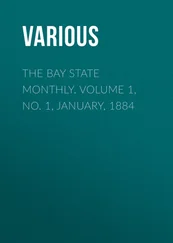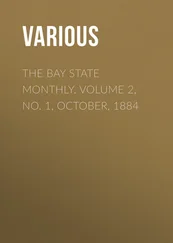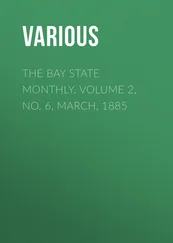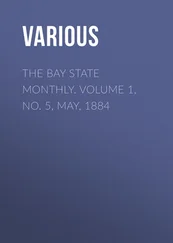Various - The Bay State Monthly. Volume 2, No. 3, December, 1884
Здесь есть возможность читать онлайн «Various - The Bay State Monthly. Volume 2, No. 3, December, 1884» — ознакомительный отрывок электронной книги совершенно бесплатно, а после прочтения отрывка купить полную версию. В некоторых случаях можно слушать аудио, скачать через торрент в формате fb2 и присутствует краткое содержание. Жанр: foreign_antique, periodic, foreign_edu, на английском языке. Описание произведения, (предисловие) а так же отзывы посетителей доступны на портале библиотеки ЛибКат.
- Название:The Bay State Monthly. Volume 2, No. 3, December, 1884
- Автор:
- Жанр:
- Год:неизвестен
- ISBN:нет данных
- Рейтинг книги:4 / 5. Голосов: 1
-
Избранное:Добавить в избранное
- Отзывы:
-
Ваша оценка:
- 80
- 1
- 2
- 3
- 4
- 5
The Bay State Monthly. Volume 2, No. 3, December, 1884: краткое содержание, описание и аннотация
Предлагаем к чтению аннотацию, описание, краткое содержание или предисловие (зависит от того, что написал сам автор книги «The Bay State Monthly. Volume 2, No. 3, December, 1884»). Если вы не нашли необходимую информацию о книге — напишите в комментариях, мы постараемся отыскать её.
The Bay State Monthly. Volume 2, No. 3, December, 1884 — читать онлайн ознакомительный отрывок
Ниже представлен текст книги, разбитый по страницам. Система сохранения места последней прочитанной страницы, позволяет с удобством читать онлайн бесплатно книгу «The Bay State Monthly. Volume 2, No. 3, December, 1884», без необходимости каждый раз заново искать на чём Вы остановились. Поставьте закладку, и сможете в любой момент перейти на страницу, на которой закончили чтение.
Интервал:
Закладка:
Various
The Bay State Monthly – Volume 2, No. 3, December, 1884
DANIEL LOTHROP
The fame, character and prosperity of a city have often depended upon its merchants,—burghers they were once called to distinguish them from haughty princes and nobles. Through the enterprise of the common citizens, Venice, Genoa, Antwerp, and London have become famous, and have controlled the destinies of nations. New England, originally settled by sturdy and liberty-loving yeomen and free citizens of free English cities, was never a congenial home for the patrician, with inherited feudal privileges, but has welcomed the thrifty Pilgrim, the Puritan, the Scotch Covenanter, the French Huguenot, the Ironsides soldiers of the great Cromwell. The men and women of this fusion have shaped our civilization. New England gave its distinctive character to the American colonies, and finally to the nation. New England influences still breathe from the Atlantic to the Pacific, and from the great lakes to Mexico; and Boston, still the focus of the New England idea, leads national movement and progress.
Perhaps one of the broadest of these influences—broadest inasmuch as it interpenetrates the life of our whole people—proceeds from the lifework of one of the merchants of Boston, known by his name and his work to the entire English speaking world: Daniel Lothrop, of the famous firm of D. Lothrop & Co., publishers—the people's publishing house. Mr. Lothrop is a good representative of this early New England fusion of race, temperament, fibre, conscience and brain. He is a direct descendant of John Lowthroppe, who, in the thirty-seventh year of Henry VIII. (1545), was a gentleman of quite extensive landed estates, both in Cherry Burton (four miles removed from Lowthorpe), and in various other parts of the country.
Lowthorpe is a small parish in the Wapentake of Dickering, in the East Riding of York, four and a half miles northeast from Great Driffield. It is a perpetual curacy in the archdeaconry of York. This parish gave name to the family of Lowthrop, Lothrop, or Lathrop. The Church, which was dedicated to St. Martin, and had for one of its chaplains, in the reign of Richard II., Robert de Louthorp, is now partly ruinated, the tower and chancel being almost entirely overgrown with ivy. It was a collegiate Church from 1333, and from the style of its architecture must have been built about the time of Edward III.
From this English John Lowthroppe the New England Lothrops have their origin:—
"It is one of the most ancient of all the famous New England families, whose blood in so many cases is better and purer than that of the so-called noble families in England. The family roll certainly shows a great deal of talent, and includes men who have proved widely influential and useful, both in the early and later periods. The pulpit has a strong representation. Educators are prominent. Soldiers prove that the family has never been wanting in courage. Lothrop missionaries have gone forth into foreign lands. The bankers are in the forefront. The publishers are represented. Art engraving has its exponent, and history has found at least one eminent student, while law and medicine are likewise indebted to this family, whose talent has been applied in every department of useful industry." 1 1 The Churchman .
GENEALOGY. 2 2 From a genealogical memoir of the Lo-Lathrop family, by Rev. E.B. Huntington, 1884.
I. Mark Lothrop, the pioneer, the grandson of John Lowthroppe and a relative of Rev. John Lothrop, settled in Salem, Mass., where he was received as an inhabitant January 11, 1643-4. He was living there in 1652. In 1656 he was living in Bridgewater, Mass., of which town he was one of the proprietors, and in which he was prominent for about twenty-five years. He died October 25, 1685.
II. Samuel Lothrop, born before 1660, married Sarah Downer, and lived in Bridgewater. His will was dated April 11, 1724.
III. Mark Lothrop, born in Bridgewater September 9, 1689; married March 29, 1722, Hannah Alden [Born February 1, 1696; died 1777]. She was the daughter of Deacon Joseph Alden of Bridgewater, and great grand-daughter of Honorable John and Priscilla (Mullins) Alden of Duxbury, of Mayflower fame. He settled in Easton, of which town he was one of the original proprietors. He was prominent in Church and town affairs.
IV. Jonathan Lothrop, born March 11, 1722-3; married April 13, 1746, Susannah, daughter of Solomon and Susannah (Edson) Johnson of Bridgewater. She was born in 1723. He was a Deacon of the Church, and a prominent man in the town. He died in 1771.
V. Solomon Lothrop, born February 9, 1761; married Mehitable, daughter of Cornelius White of Taunlon; settled in Easton, and later in Norton, where he died October 19, 1843. She died September 14, 1832, aged 73.
VI. Daniel Lothrop, born in Easton, January 9, 1801; married October 16, 1825, Sophia, daughter of Deacon Jeremiah Horne of Rochester, N.H. She died September 23, 1848, and he married (2) Mary E. Chamberlain. He settled in Rochester, N.H., and was one of the public men of the town. Of the strictest integrity, and possessing sterling qualities of mind and heart Mr. Lothrop was chosen to fill important offices of public trust in his town and state. He repeatedly represented his town in the Legislature, where his sound practical sense and clear wisdom were of much service, particularly in the formation of the Free Soil party, in which he was a bold defender of the rights of liberty to all men. He died May 31, 1870.
VII. Daniel Lothrop, son of Daniel and Sophia (Horne) Lothrop, was born in Rochester, N.H., August 11, 1831.
"On the maternal side Mr. Lothrop is descended from William Horne, of Horne's Hill, in Dover, who held his exposed position in the Indian wars, and whose estate has been in the family name from 1662 until the present generation; but he was killed in the massacre of June 28, 1689. Through the Horne line, also, came descent from Rev. Joseph Hull, minister at Durham in 1662, a graduate at the University at Cambridge, England; from John Ham, of Dover; from the emigrant John Heard, and others of like vigorous stock. It was his ancestress, Elizabeth (Hull) Heard, whom the old historians call a "brave gentlewoman," who held her garrison house, the frontier fort in Dover in the Indian wars, and successfully defended it in the massacre of 1689. The father of the subject of this sketch was a man of sterling qualities, strong in mind and will, but commanding love as well as respect. The mother was a woman of outward beauty and beauty of soul alike; with high ideals and reverent conscientiousness. Her influence over her boys was life-long. The home was a centre of intelligent intercourse, a sample of the simplicity but earnestness of many of the best New Hampshire homesteads." 3 3 Rec. Alonzo H. Quint, D.D. in Granite Monthly .
Descended, as is here evident, from men and women accustomed to govern, legislate, protect, guide and represent the people, it is not surprising to find the Lothrops of the present day of this branch standing in high places, shaping affairs, and devising fresh and far-reaching measures for the general good.
Daniel Lothrop was the youngest of the three sons of Daniel and Sophia Home Lothrop. The family residence was on Haven's Hill, in Rochester, and it was an ideal home in its laws, influences and pleasures. Under the guidance of the wise and gentle mother young Daniel developed in a sound body a mind intent on lofty aims, even in childhood, and a character early distinguished for sturdy uprightness. Here, too, on the farm was instilled into him the faith of his fathers, brought through many generations, and he openly acknowledged his allegiance to an Evangelical Church at the age of eleven.
Читать дальшеИнтервал:
Закладка:
Похожие книги на «The Bay State Monthly. Volume 2, No. 3, December, 1884»
Представляем Вашему вниманию похожие книги на «The Bay State Monthly. Volume 2, No. 3, December, 1884» списком для выбора. Мы отобрали схожую по названию и смыслу литературу в надежде предоставить читателям больше вариантов отыскать новые, интересные, ещё непрочитанные произведения.
Обсуждение, отзывы о книге «The Bay State Monthly. Volume 2, No. 3, December, 1884» и просто собственные мнения читателей. Оставьте ваши комментарии, напишите, что Вы думаете о произведении, его смысле или главных героях. Укажите что конкретно понравилось, а что нет, и почему Вы так считаете.












